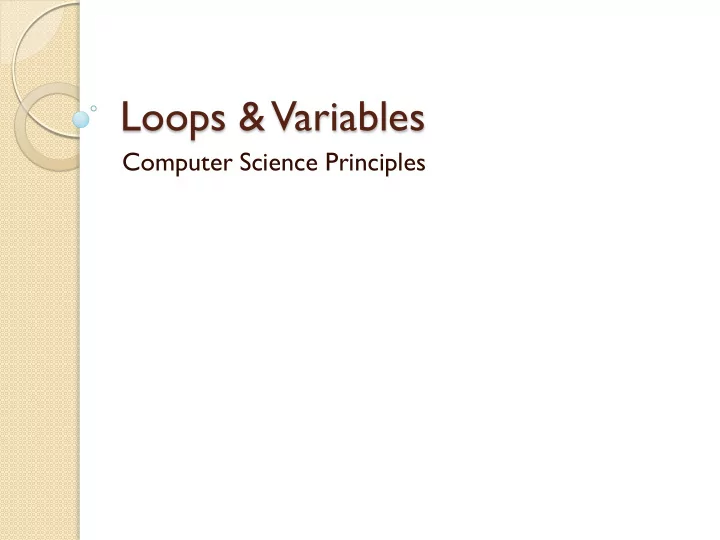

Loops & Variables Computer Science Principles
VARIABLES
What is a Variable? A variable is a named space in memory. Think of a mailroom with a large wall of slots for the mail as your memory. ◦ This is very simplified of course. Each of these slots would be assigned to a variable (by its name) and would hold the values assigned. Variable Value Variable Name
Adding Variables You can add variables to your program to increase its flexibility. The variable allows you to change a value as the script runs. T o add a variable, select the Variables tab, then click on the Make a Variable button.
Creating a Variable When you click on the Make a Variable button, the Variable Name window will open. Note you can create the variable for the active sprite only (called a local variable) or for all sprites (called a global variable).
Variable Blocks You have multiple variable blocks. ◦ Checking the checkbox beside a variable name will display the value of the variable on the stage. (only visible when there is a variable.) ◦ set [ variableName ] to () Sets the value ◦ change [ variableName ] by () Changes the value ◦ show variable [ variableName ] Displays the value on the stage. ◦ hide variable [ variableName ] Displays the value on the stage. ◦ script variables (a) Creates local variables
Example of Variable Use Create a variable called mynote that will be the value of what note is played. ◦ Now the note will change as the loop runs (from using the repeat () block). ◦ Note that we had to give the variable a starting value. This is called initializing the variable.
Set vs. Change Note that using a set [variableName] to () block will set the value of the variable – NOT update it. T o update or change a value, use the change [variableName] by () block.
LOOPING
Looping There are times when we want certain blocks to repeat more than one time. There are blocks that allow us to do just that. ◦ Warp Does not show the interim steps – only the final product ◦ forever Will continue to loop until the program closes This is basically an infinite loop as it goes on forever.. ◦ repeat () Will continue to loop the specified number of times. ◦ repeat until < > Will continue to loop until the condition is met ( true )
Helping Blocks There are blocks that you will want to use with your variables and loops. These blocks are in the Operator’s palette.
Looping Blocks Will continue to play the Bubbles sound. Will play the Bubbles sound three times
Looping Example Will ask the question, then wait for the answer. If the answer is “yes” it will play the Bubbles sound. Then ask the question again and wait for the answer. Playing and asking the question will continue to loop until the answer is something other than “yes”
Looping Example Let’s look at the "repeat until" block a bit closer. Just like REPEAT, it will do everything inside the C-shaped block a certain number of times. However before it starts the loop each time, it checks to see if the condition (x > 5) is true. When this is condition is true, it will not repeat again.
Looping Errors Remember to ALWAYS increment your loop to avoid unintentional infinite loops. Check that your bounds complete the iterations that you need.
repeat until <> Value of x
DRAWING BLOCKS
Important Blocks for Drawing There are several blocks you will use to draw. ◦ move () steps Will move your sprite which will draw for you. ◦ turn () degrees Will turn your sprite to face that direction ◦ clear Will clear your stage ◦ pen down Will tell the sprite to start drawing ◦ pen up Will tell the sprite to stop drawing
Changing Sprite Size In order to see your drawing, you might want to change the size of your sprite. In the Looks area, you will set the set size to () % block.
Where is my Sprite? You might also need to know where your sprite is located by the x and y positions as well as the direction your sprite is facing on the stage. Look in the Motion area, you will see the several blocks you can use. By checking these blocks, the information will be displayed on the stage.
Recommend
More recommend